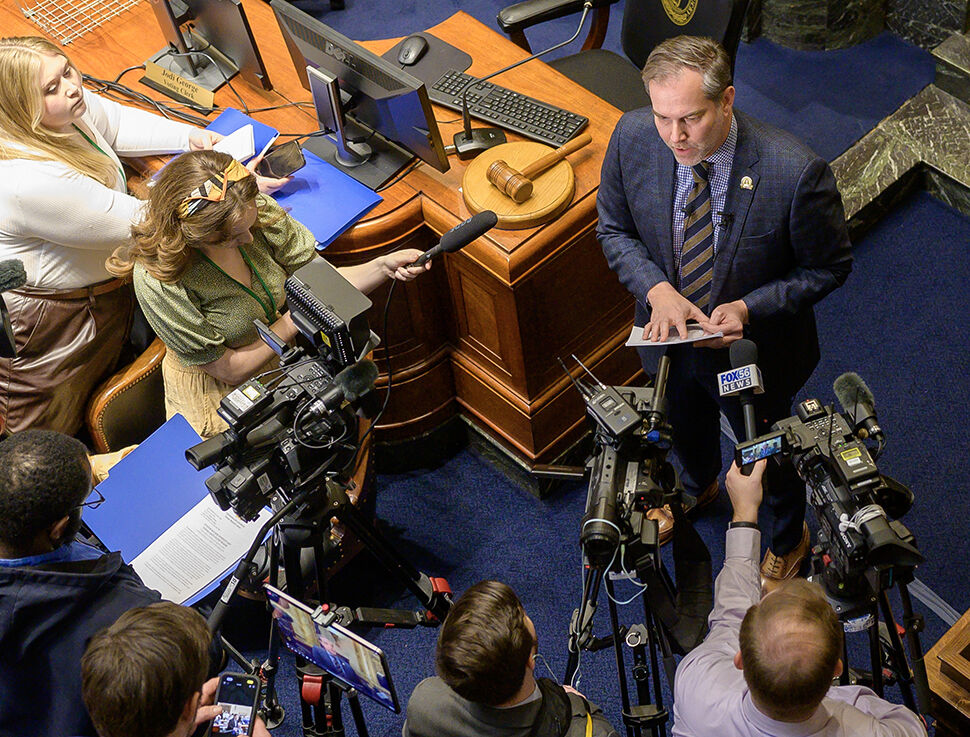As youth mental health worsens, support stagnates
Published 3:08 pm Friday, August 16, 2024

- State Sen. Max Wise, R-Campbellsville, is surrounded by media recently as he fields questions on Senate Bill 2, legislation focused on school safety. (LRC)
By SARAH MICHELS, Bowling Green Daily News
This is the final installment of the Educating Kentucky series examining issues in state schools. All the stories are available at bgdailynews.com.
Managing all the in-person and online bullying kids face after COVID has become an all-day job for one rural Kentucky school counselor.
Younger kids are acting out more, can’t hold attention and aren’t getting along well with others, she said.
The older kids, in fourth and fifth grades, are experiencing more depression and anxiety. Some are self-harming, which never happened that young before, she added.
“I’ve seen this explosion of social media and kids getting phones at a younger age, and it’s becoming a huge problem,” the counselor said.
According to the National Survey of Children’s Health, between 2019 and 2020 there was a 21% increase in children diagnosed with behavioral or conduct problems.
In 2021, Kentucky teens from grades 6 to 12 reported higher levels of serious psychological distress, like depression and anxiety, according to a Kentucky Incentives for Prevention survey. On average, distress increased by 4% from 2018-21.
Youth mental health doesn’t appear to be improving further out from the pandemic. In 2023, a quarter of Kentucky middle school students reported that their mental health was not good most or all of the time, according to the Youth Risk Behavior Survey.
In 2019, the Kentucky legislature passed the School Safety and Resiliency Act, which includes provisions meant to address mental health treatment gaps in schools.
Under the updated law, each school district is asked to hire at least one school counselor in each school, with the goal of meeting a 1:250 school counselor to student ratio, “as funds and qualified personnel become available.”
For the past two budgets, the state has provided each district $43,000 to fund school-based mental health service provider positions.
According to school leaders across the commonwealth, it hasn’t been enough to stem the rising tide of mental illness.
The search for mental health professionals
School leaders cite a series of issues about hiring enough mental health professionals to adequately serve students: a lack of funding, access to qualified personnel and direct face time with students in need.
One southcentral Kentucky superintendent said most school districts probably lean closer to the 1:500 counselor to student ratio, double what the law sets as a goal.
It costs more than the state provides to hire mental health professionals, and so funds have to come from districts’ already-strapped general fund budgets, he said.
“It’s interesting that we acknowledge the importance of having a counselor for every 250 students, but there’s little effort to ensure that the resources are available to execute that type of scenario,” he said.
His district secured a grant to expand services, but it expires soon.
“With the conclusion of that grant, and the rise of mental health cases that we continue to see, unfortunately, we’re not in a position to provide the same number of mental health counselors that we had previously,” the superintendent said.
Many other districts have contracted with outside partners to fill the gap. But in more rural areas, there may not be as much access to qualified professionals.
One central Kentucky superintendent said his district has enough money to hire an additional counselor in each school, but it would come at the cost of something else, like a teacher.
Even if his district did decide to hire more mental health professionals, he said they are competing with other industries, like social work, also experiencing mental health worker shortages.
The School Safety and Resiliency Act states that counselors should aim to spend at least 60% of their time providing direct services to students, like one-on-one and group sessions or classroom visits.
The rural school counselor said in a good year, she spends more like 40% of her time with students. Other duties, like record-keeping, get in the way of more face time.
Several superintendents confirmed this trend. One said their district’s school psychologist spends most of their time completing evaluations for special education.
“We try to have counselors in our school, but then our counselors are so inundated with all the compliance activities and all the different things that they have to do,” said another superintendent in an eastern Kentucky district.
Social emotional learning
Sen. Matthew Deneen, R-Elizabethtown, thinks part of the mental health crisis is due to the “nonsocial environment” created during the pandemic and through the proliferation of smartphones.
“Relationships take time. Friendships take time,” he said. “They’re not something you can do in a 10-second meme or a 30-second reel. It’s not something you can hide behind a text message on. Any progress with an individual really begins with relationships.”
Deneen said the solution to mental health issues is making sure students have a connection with an adult in the building, whether a coach, counselor or teacher, who can encourage and support them.
Social emotional learning is a method by which people develop the skills to manage their emotions, create relationships, make responsible decisions and gain a sense of self and social awareness. As students’ loss of social skills becomes clear, schools are implementing SEL lessons into class.
SEL has become a hot topic politically. Miranda Stovall, vice president of No Left Turn in Education’s Kentucky chapter, isn’t a fan.
She told a story about her first-grade daughter being asked to share a time she was scared with a group of her peers during an SEL lesson when school was virtual.
“I was like, ‘no, we’re not going to do that.’ She doesn’t need to reminisce on a time, she was really, really scared,” Stovall said. “She needs to reminisce on the fact of, ‘I got over that, I faced my fear.’ “
Stovall sees SEL as a sort of unnecessary group therapy that teachers are not equipped to conduct. Not every kid has trauma, she said.
“If you’re wasting money blanketing the entire school or district with this model, instead of using those funds for those wraparound services for those kids that truly need it, to me, that’s an injustice,” Stovall said.
The school counselor, however, said tanking social emotional learning is doing a disservice to students and their future potential for success.
“Social emotional learning is about making relationship skills and social skills and just working with others,” she said. “That’s where the ball is being dropped. So if we chuck out social emotional learning, and we don’t allow that in our schools, we’re not preparing students to be a part of a workforce.”





